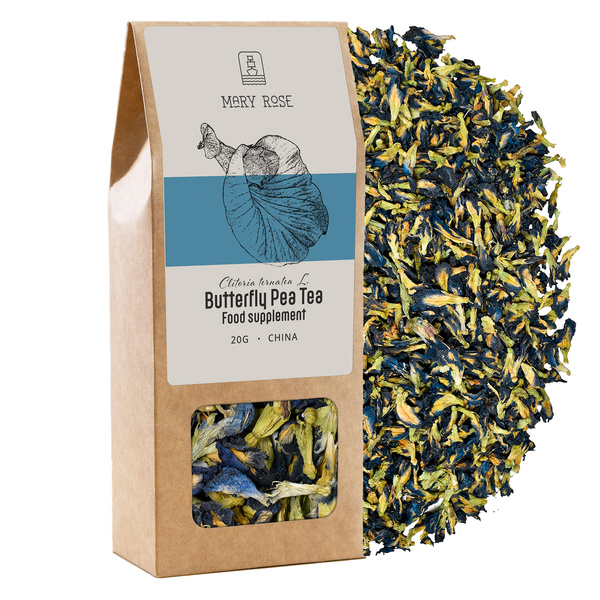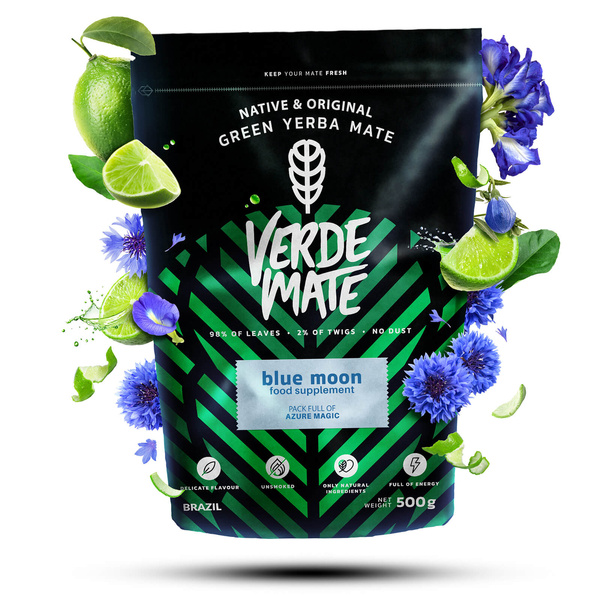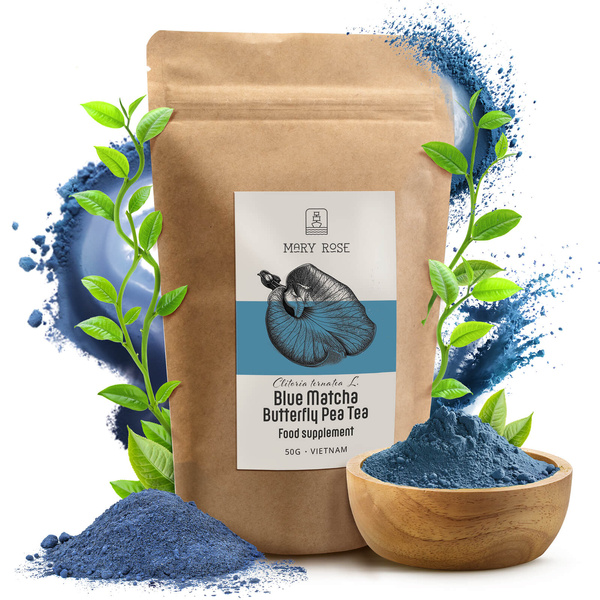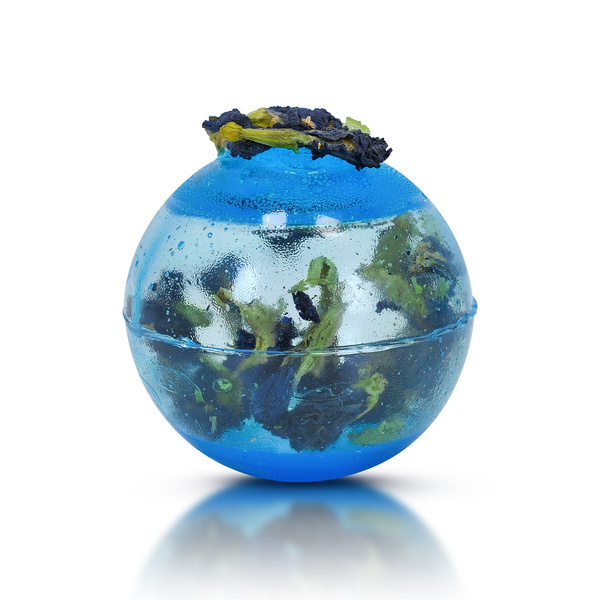Butterfly Pea Tea – the blue tea from Clitoria ternatea. Discover its properties and uses!
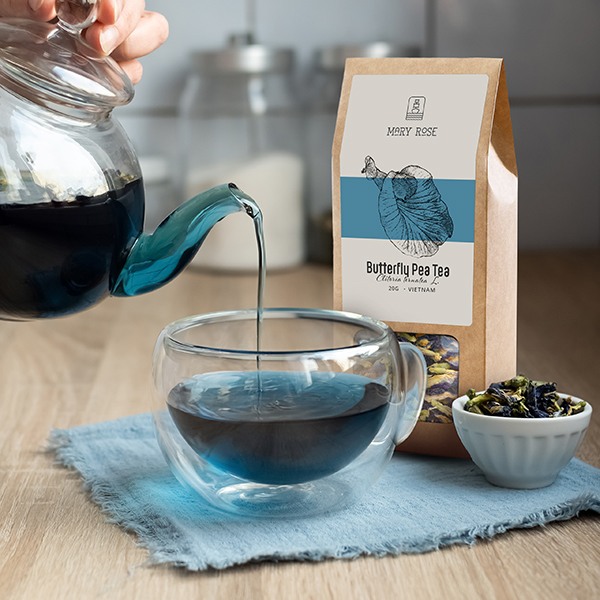
Can tea still surprise us? It turns out it can! Butterfly pea tea, also known as tea made from Clitoria ternatea, is an infusion that delights not only with its flavour but above all with its colour. Intensely blue, and turning purple or pink when lemon juice is added – this drink has taken the world by storm among lovers of natural products and those who appreciate beautiful, Instagram-worthy photos.
This remarkable tea has gained popularity across the globe, although its roots date back hundreds of years to the countries of Southeast Asia, where Clitoria ternatea has long served as a traditional drink, dye and plant valued for its beneficial natural properties.
In this post, we will take a closer look at what exactly Clitoria ternatea is, what its flower looks like and how it is used – from cuisine to natural medicine. You will also learn how to prepare butterfly pea tea, what its effects and flavour are, and why it deserves a place in your home collection of teas and herbs.
Summary:
- What is Clitoria ternatea?
- How to brew and what does butterfly pea tea taste like?
- Butterfly pea tea properties – why is it worth drinking?
- Clitoria ternatea contraindications
- Why should you try butterfly pea tea?
What is Clitoria ternatea?
Clitoria ternatea (Latin: Clitoria ternatea) is a climbing plant that grows mainly in the tropical climate of Southeast Asia – in Thailand, Vietnam, India and Indonesia. Its most characteristic feature is its deep blue, large flowers, which immediately catch the eye. These are the very flowers used to make butterfly pea tea, a beverage of an exceptionally intense blue colour that continues to gain popularity around the world.
Besides its visual charm, the flower of Clitoria ternatea has a wide range of uses, being employed in various fields:
- 🔹 In cuisine – as an infusion and a natural colouring for desserts, rice or drinks;
- 🔹 In cosmetics – in the form of extracts used in skincare products;
- 🔹 In herbal traditions – it has been traditionally attributed with toning, relaxing and memory-supporting properties.
Interestingly, in addition to the classic tea made from dried flowers, the market now also offers powdered Clitoria ternatea – sold under the somewhat playful name Blue Matcha. Although technically it is not Japanese green matcha, it is prepared in a similar manner and looks equally stunning in a cup. You can find both forms of Clitoria in our store MateMundo.co.uk.
Clitoria flower – appearance and traditional uses
The flowers of Clitoria ternatea are exceptionally striking – large, with an intensely blue hue and a delicate light centre. Their appearance alone makes the plant a popular ornamental species, but its greatest significance lies in its use in cuisine and traditional medicine.
In Asia, it has been used for centuries:
- In Thai cuisine, the flowers are used to make drinks, lemonades and colourful desserts;
- In India and Sri Lanka, they are used to colour rice and pastries;
- In Ayurveda, Clitoria ternatea is regarded as a plant that helps support focus, memory and calm the nervous system.
💡 Fun fact: Clitoria ternatea is also known by its English name butterfly pea, referring both to the shape and the deep colour of its petals.
Clitoria ternatea – dried flowers and their use in infusions
To prepare an infusion, dried Clitoria flowers are most commonly used, retaining their deep sapphire colour and natural qualities. It is from these that the famous butterfly pea tea is brewed. When covered with hot water, the petals create a drink of stunning blue colour – a shade reminiscent of the ocean. What’s more, this infusion can “surprise” you – just add a few drops of lemon juice and the blue turns into shades of pink or violet!
In herbal and online stores, you can find both dried whole Clitoria blossoms and powdered versions – i.e. the aforementioned Blue Matcha. This means every tea lover or fan of natural infusions can choose the form that suits them best.
If you want to try this unique tea, be sure to visit our shop, where you’ll find:
- 👉 Mary Rose - Butterfly Pea Tea - 20 g (whole flowers)
- 👉 Mary Rose – Blue Matcha – Butterfly Pea Tea (powder) – available in two sizes: 50 g and 100 g
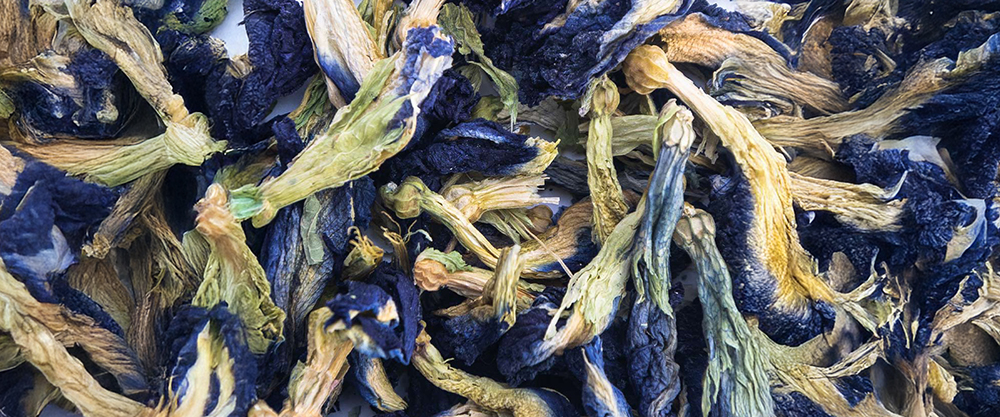
Butterfly Pea Tea – how to brew it and what does it taste like?
In the previous section, we explored what Clitoria ternatea is and how its blossoms have been used for centuries in both cooking and traditional medicine. Now it’s time for some practical tips – how exactly should you prepare blue butterfly tea, and what flavour sensations can you expect? While its breathtaking blue hue grabs the spotlight, its delicate aroma and mild flavour make it just as special.
How to brew Butterfly Pea Tea – step by step
Preparing Clitoria ternatea tea is very simple and doesn’t require any special tools – all you need are dried petals and hot water. However, to enjoy its natural colour and subtle taste to the fullest, it’s worth following a few simple steps:
☕ Clitoria ternatea – How to Brew
- Add 4–5 dried Clitoria flowers (around 1 g) into a cup or teapot.
- Pour hot water (90–100°C) over the flowers and let them steep for about 10 minutes.
- Watch as the liquid takes on a deep, vivid blue colour – one of the most mesmerising moments of the brewing process!
- Optionally, add a few drops of lemon juice – the acidity will turn the tea’s shade from blue to pinkish-purple.
The recommended daily portion of dried Clitoria flowers is up to about 1 g (4–5 flowers). Butterfly pea tea should be treated as a supplement to a balanced diet, not a replacement for it.
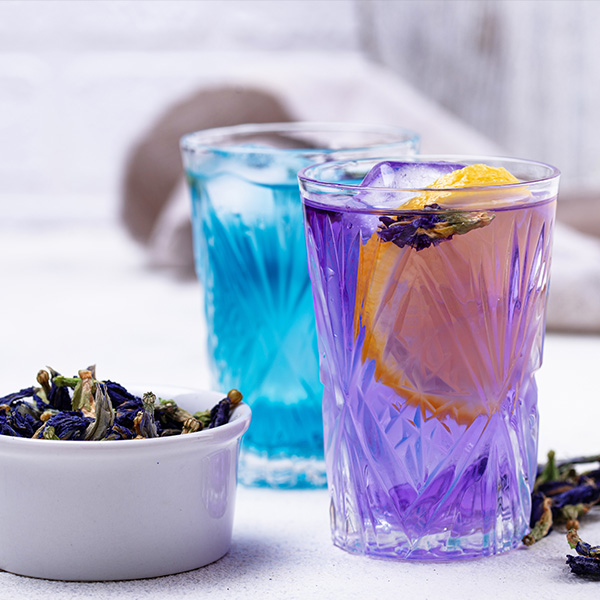
The finished infusion can be enjoyed on its own, but many tea enthusiasts experiment by combining Clitoria flowers with other herbs and teas such as lemongrass, hibiscus, green tea or even yerba mate. Blue butterfly tea is therefore a perfect base not only for everyday sipping but also for creative blends – both in flavour and in colour.
💡 Tip: For a truly impressive effect, add ice cubes and freshly squeezed citrus juice to the ready infusion – the blue will shift smoothly into shades of violet. It’s a fantastic base for summer lemonades and cocktails!
Clitoria ternatea – flavour and aroma of the infusion
Although the captivating colour of Clitoria ternatea often steals the show, its flavour is worth equal attention. Unlike intensely aromatic teas, Clitoria ternatea tea has an exceptionally delicate character:
- ✔️ Gently herbal and vegetal in flavour;
- ✔️ With subtle notes reminiscent of green tea;
- ✔️ Lightly refreshing yet very mild on the palate.
Thanks to its neutrality, Clitoria flower tea works perfectly as a base for other drinks – both hot and cold. In Asian cuisine, it is used to create lemonades, cocktails and desserts that impress with both flavour and spectacular appearance.
If you prefer more aromatic or complex blends, there’s nothing stopping you from combining Clitoria flowers with other ingredients – such as ginger, lemongrass, dried hibiscus or mint leaves. In every variation, the infusion is not only visually stunning but also pleasantly calming – a great choice for those who seek not just an attractive brew but also a soothing tea experience.
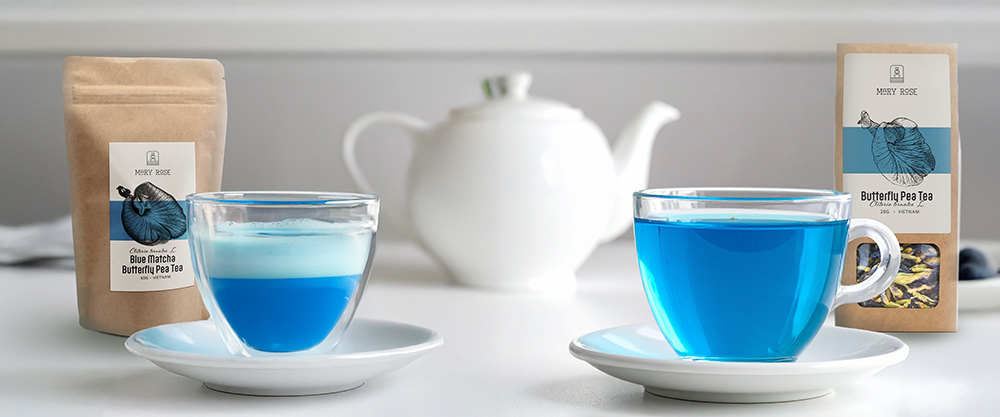
Butterfly Pea Tea properties – why is it worth drinking?
Although blue butterfly tea is best known for its spectacular colour, its uniqueness goes beyond appearance. Clitoria ternatea – and the tea made from its blossoms – owes its beneficial properties to an array of valuable plant compounds, including natural antioxidants that help protect the body on many levels. It’s no wonder that butterfly pea flowers have held an important place for centuries not only in Asian cuisine but also in traditional medicine, particularly Ayurveda.
Drinking Clitoria flower tea regularly is associated with the following benefits:
- 💙 A rich source of natural pigments – the blossoms of Clitoria ternatea contain plant compounds responsible for their vivid blue colour. These pigments not only create a beautiful drink but are often mentioned for their antioxidant potential.
- 💙 Traditionally linked to supporting the mind – in Ayurveda, Clitoria ternatea has been valued as a plant used in practices aimed at aiding concentration and memory. While modern science continues to study its properties, it remains culturally known as the “herb for the mind”.
- 💙 A natural relaxation drink – its gentle flavour and mild aroma make butterfly pea tea a popular addition to evening relaxation rituals. The association between this tea and a sense of calm has roots both in Eastern traditions and in modern wellness trends.
- 💙 Inner balance and harmony – throughout various cultures, Clitoria ternatea tea has been regarded as a drink that promotes emotional balance and inner peace. This timeless perception still inspires tea lovers today.
For all these reasons, blue butterfly tea and its properties are highly appreciated not only in the regions where it originates but also worldwide, as more and more people discover its appeal. It captivates with its colour and delicate flavour, while also being appreciated by those seeking simple, natural ways to unwind and focus amid the hustle and bustle of modern life.
💡 Ayurvedic Insight: In Ayurvedic medicine, Clitoria ternatea flowers belong to a group of herbs known as “Medhya Rasayana” – plants believed to support memory, cognitive functions and inner balance. Hence, it is sometimes referred to as the natural “herb of mental calm”.
It’s worth remembering that, despite its many valuable aspects, Clitoria ternatea tea should be seen as part of a balanced diet and a healthy lifestyle – not as a miracle remedy for all ailments. It’s a delightful addition to your daily routine, especially if you’re looking for a natural way to relax, focus and take a peaceful pause in your day.
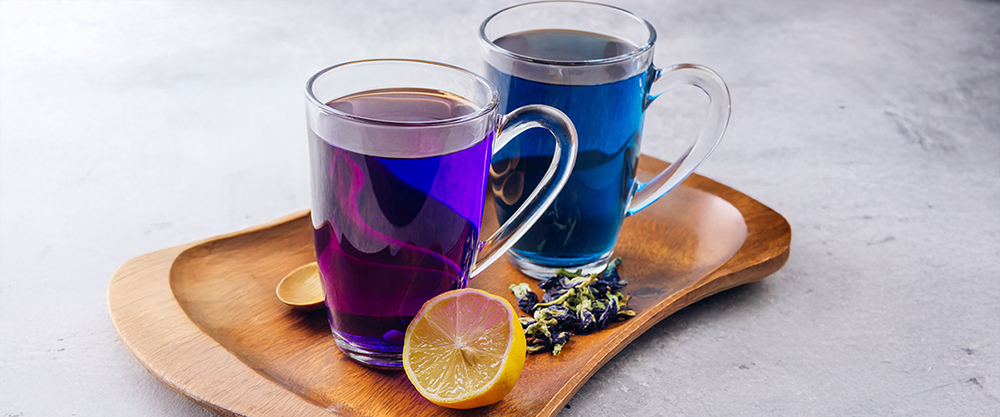
Clitoria ternatea – contraindications
Although butterfly pea tea impresses with its appearance and is often enjoyed as part of a healthy lifestyle, it’s important to remember that – as with any herbal product – certain precautions should be kept in mind. When it comes to Clitoria ternatea contraindications, they are not extensive, but it’s worth knowing in which cases caution is advised.
- ⚠️ Pregnant and breastfeeding women – there is insufficient research on the safety of consuming this infusion during these periods, so it’s best to avoid it or consult a doctor beforehand.
- ⚠️ People taking anticoagulant medications – plants containing certain bioactive compounds can interact with medicines, so it’s wise to exercise caution and consult your healthcare provider before supplementing.
- ⚠️ Individuals prone to allergies – as with many herbs, some sensitive individuals may experience allergic reactions, particularly upon first exposure to the infusion.
Other than that, Clitoria ternatea tea is considered relatively safe. The recommended maximum daily portion is around 1 g of dried flowers, which equals an infusion made from 4–5 blossoms. It’s best to start with small amounts and observe the body’s response. Remember that Clitoria ternatea tea should be viewed primarily as an enjoyable supplement and culinary addition, rather than a medicine or dietary replacement.
❗ Note:
If you suffer from chronic conditions, take medication regularly or are unsure whether Clitoria ternatea is suitable for you, consult your doctor. This way, you can be confident that butterfly pea tea becomes a safe and pleasant part of your daily wellness rituals.
Why should you try Butterfly Pea Tea?
To sum up, butterfly pea tea – Clitoria ternatea is a drink that surprises on many levels. On the one hand, it enchants with its extraordinary, deeply blue hue that can transform into shades of purple or pink – making it one of the most visually stunning teas in the world. On the other hand, it offers a subtle flavour and aroma, making it perfect as a gentle everyday brew or as a delicate base for lemonades, cocktails and desserts.
Clitoria – flowers and the tea made from them have accompanied the people of Asia for centuries as both a beverage and a natural dye. Today, it’s winning over enthusiasts of healthy living and lovers of aesthetically pleasing wellness rituals. Its preparation is simple, and the result – spectacular, whether you enjoy it on its own or in mixes with other herbs.
One could say that blue butterfly tea combines the best the world of natural infusions has to offer: beauty, flavour and a gentle sense of wellbeing. It’s the perfect choice for anyone seeking something unique – delighting both the palate and the eyes!
Why not give it a try? If you want to experience just how exceptional butterfly pea tea looks and tastes, visit our shop. You’ll find both dried Clitoria blossoms and the beautiful powdered version – Blue Matcha – choose the form that best suits your needs and discover its enchanting qualities!
And if you’re eager to explore more flavours – take a look at our wide range of herbal teas:
❓ FAQ – Frequently Asked Questions About Butterfly Pea Tea (Clitoria Ternatea)
1. What exactly is butterfly pea tea?
2. How do you brew butterfly pea tea?
3. What does Clitoria Ternatea tea taste like?
4. What are the properties of butterfly pea tea?
5. Are there any contraindications to drinking Clitoria Ternatea tea?
6. Where can I buy butterfly pea tea?
Sources of information:
- Wikipedia: Clitoria ternatea, Butterfly pea flower tea.
- P. Kosai et al., Review on Ethnomedicinal Uses of Memory Boosting Herb, Butterfly Pea, Clitoria ternatea, Journal of Natural Remedies, 2015.

